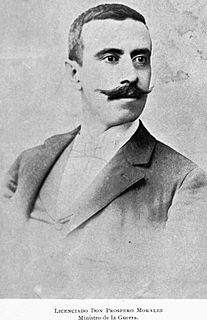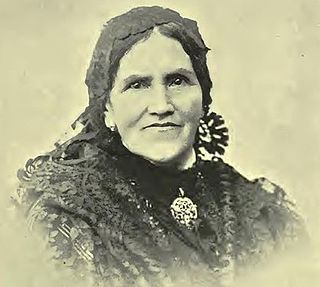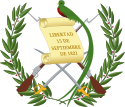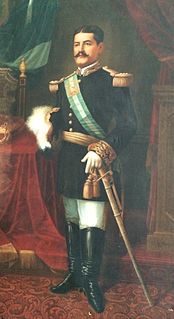
Manuel José Estrada Cabrera was President of Guatemala from 1898 to 1920. He was a lawyer with no military background and as President, he was a strong ruler, who modernised the country’s industry and transport, but only by granting concessions to the American-owned United Fruit Company, whose influence on the government was felt by many to be excessive. Estrada Cabrera used increasingly brutal methods to assert his authority, including armed strike-breaking, and the general elections were effectively controlled by him. He retained power for 22 years through controlled elections in 1904, 1910, and 1916, and was eventually removed from office when the national assembly declared him mentally incompetent, and he was jailed for corruption.

Manuel Lisandro Barillas Bercián was a Guatemalan general and acting president of Guatemala from 6 April 1885 to 15 March 1886 and President from 16 March 1886 to 15 March 1892. He was born in Quetzaltenango, and assassinated in Mexico City in 1907.

Salamá is a city in Guatemala. It is the capital of the department of Baja Verapaz and it is situated at 940 m above sea level. The municipality of Salamá, for which the city of Salamá serves as the administrative centre, covers a total surface area of 776 km² and contains 40,000 people.

Lorenzo Montúfar y Rivera was a Guatemalan politician and lawyer. Superb leader and speaker, helped the liberal regime of Justo Rufino Barrios, served in the Guatemalan legislature, taught in the College of Law of the Universidad Nacional de Guatemala and, towards the end of his life, was a presidential candidate himself losing to general José María Reyna Barrios. He was also Foreign Secretary of Costa Rica in 1856 and from 1870 to 1873, and President of University of Saint Thomas, also in Costa Rica.

José Batres Montúfar (1809–1844) was a Guatemalan poet, politician, engineer and military figure.

Presidential elections were held in Guatemala during seven days in September 1898. Prior to the elections Manuel Estrada Cabrera had established the first real political party in the country's history by admitting people from outside the influential liberals to the Liberal Party.

Presidential elections were held in Guatemala in July 1904. The result was a victory for Manuel Estrada Cabrera, who received all but three of the national votes. He assumed the presidency on 15 March 1905.

Presidential elections were held in Guatemala on 11 April 1910. Manuel Estrada Cabrera was re-elected unopposed. He assumed the presidency on 15 March 1911.

Presidential elections were held in Guatemala on 17 January 1916. For the second successive election, Manuel Estrada Cabrera was re-elected unopposed. Despite there only being one candidate, voters were rounded up by the military and taken to polling stations, where they could only vote for Cabrera. Cabrera assumed the presidency on 15 March 1911.

Luis Batres Juarros or Luis Batres y Juarros was an influential conservative Guatemalan politician during the regime of General Rafael Carrera. Member of the Aycinena clan, was in charge of writing most of the legislation that was enacted during this period. The liberal historians portray him as a villain in a despotic and tyrannical government headed by illiterate Raca Carraca - Rafael Carrera - who was taking each and every one of Batres recommendations since he was considered infallible; However, research conducted between 1980 and 2010 has shown a more objective biography of both Batres and Rafael Carrera and show that it was in fact Carrera who had the reins of the Conservative government.

Natalia Górriz de Morales was a Guatemalan teacher, pedagogue, and the founder of the Instituto Normal Central para Señoritas in 1888. In 1892, the government of General José María Reina Barrios promoted her to the post of Inspector General of Girls' Schools in Guatemala City. She wrote a book dedicated to Christopher Columbus in honor of that year's fourth centenary of his landing. Her teaching career was put on hold when she married Próspero Morales, in 1894, but after his death in 1898, she started teaching again.

Rafael Spínola was a writer, journalist, politician and public speaker from Guatemala. Director of the well known cultura magazine La Ilustración Guatemalteca in 1896 and 1897, was Secretary of Infrastructure in Manuel Estrada Cabrera first presidential term. He also created the "Fiestas Minervalias", which were a celebration to the studious youth and the president Estrada Cabrera rule. He was also the one that signed the treaty granting the American company "The Central American Improvement Co. Inc." to finish the Northern Railroad -which had been left unfinished after president José María Reina Barrios assassination on 8 February 1898–, which would be the stepping stone for the operations of the United Fruit Company in Guatemala. He was the father of Guatemalan poetesse Magdalena Spínola (1896–1991).

La Ilustración Guatemalteca was a biweekly cultural magazine that was published in Guatemala from 1 July 1896 to 15 June 1898. At a time when only 5% of the Guatemalan population could read, this magazine had extended articles aimed for the society elite and described numerous episodes of the later years of the presidency of general José María Reina Barrios, especially the economic crisis that originated when coffee -principal export from Guatemala at the time- and silver international prices plummeted. It also described the Exposición Centroamericana -Central American Exposition-, an event that Reina Barrios organized to showcast the Interoceanic railroad in Guatemala -at a time when the Panama Canal had not yet being built- and get Guatemala out of the crisis by means of international investors interested in move their products from the Atlantic to the Pacific Ocean. The magazine presented a good amount of pictures made by Alberto G. Valdeavellano, a photography pioneer from Guatemala.

Próspero Morales was a Guatemalan lawyer who served as Secretary of Infrastructure, War and Public Instruction during José María Reina Barrios administration. Two year after being in office, Morales married the well known Guatemalan teacher Natalia Górriz. Morales resigned as Secretary on 5 March 1897 in order to run for president for the upcoming presidential elections; however, due to the failure of the Exposición Centroamericana and the severe economic crisis that Guatemala was undergoing at the time, due to the plummeting of coffee and silver international prices, general Reina Barrios suspended the elections and forcibly extended his tenure until 1902. Morales then joined the revolution that was brewing in Quetzaltenango, but the rebels were defeated on 14 September 1897. After Reina Barrios assassination on 8 February 1898, he unsuccessfully tried to overthrow interim president Manuel Estrada Cabrera–who also had served as Secretary under Reina Barrios–but was repelled by the forces of former president Manuel Lisandro Barillas.

Presidential elections were held in Guatemala in November 1873. Justo Rufino Barrios wins the presidency.

Presidential elections were held in Guatemala in November 1880.

Algeria Benton de Reyna Barrios was the First Lady of Guatemala and wife of President José María Reyna Barrios. Benton married Reina Barrios on May 17, 1886, at the consulate of Guatemala in New York, whose consul was Enrique Toriello.

Celia Barrios Mazariegos de Reina was the mother of President José María Reina Barrios and the 1st First Mother of Guatemala, and the sister of President Justo Rufino Barrios.






















